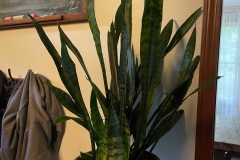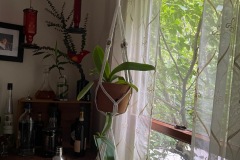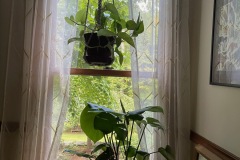Amaryllis, Colocasia, Black-eyed susan vine, returning houseplants, orchids, and overwintering tropicals…
Most of the houseplants and tropicals have made it indoors at this point. Caladiums, canna, calla, dahlias, gladiolus all still keeping on until the first frost and will all be stored in the basement or garage.
I sometimes dig those up before the first frost if I have time or am impatient or bored or ready for everything to be over. Most of those tender perennials have tubers or corms that need to be relatively dry for storage, so it’s a matter of timing against the rains and giving them time to cure before it’s freezing. I’m overwintering papyrus and Alocasia as houseplants this year, in a water feature, but haven’t gotten around to facing that yet.
AMARYLLIS

Here are the large Amaryllis, dug up and hanging in the basement, looking like the mouth parts of space worms.
Image below from a more dignified time mid-summer. They were excellent container garden foliage plants and worked well with what is basically a farm for sedum, where ‘John Creech’ and ‘Angelina’ proliferate then are moved to areas that need need more ground cover. There’s also a Boulevard clematis (‘Chelsea’) and a yucca and a castor bean vine, so this is not the most well-thought out container – more like a lovingly-filled junk drawer – but it looked okay and nobody died.
“It looked okay and nobody died” isn’t a bad goal.

Once the Amaryllis foliage has withered and the bulbs are dormant, I’ll give them two months before potting up — so potting up in late December for a late February bloom since they came in a bit late. There is a lot of moisture in those bulbs so it will take time for the leaves to whither, but they are weakening after a week or so.
A few more Amaryllis bulbs, smaller than golf balls, will grow as houseplants all winter, be planted outside in the spring, and hope to see them reach blooming size by next fall. Overwintering and getting Amaryllis to rebloom has been spotty, but I’m optimistic because of the expansion of bulb size this summer.
HIBISCUS
The two tropical hibiscus, in bloom, sprayed hard with water once, twice, a third time. Prone to spider mites indoors but otherwise reasonably easily overwintered. Root pruned the one in the smaller pot. Steak knife; second most important garden tool after hands.


COLOCASIA AND FICUS
Elephant ears, ficus, also hit w/fierce water spray, hauled in.


LEMON TREES
 Lemon trees, one fully in bloom, move into living room. We drove to Disneyworld, from Buffalo to Florida, when I was a kid, and I remember driving through the orange groves and the smell. I didn’t think I’d ever smell that again. Come November, it’s crazy to be in New England, a fire in the fireplace, and the the living room filled with the smell of citrus blooms that I haven’t experienced in forty years.
Lemon trees, one fully in bloom, move into living room. We drove to Disneyworld, from Buffalo to Florida, when I was a kid, and I remember driving through the orange groves and the smell. I didn’t think I’d ever smell that again. Come November, it’s crazy to be in New England, a fire in the fireplace, and the the living room filled with the smell of citrus blooms that I haven’t experienced in forty years.
BLACK EYED SUSAN VINE
Black eyed susan vine, which wants to be fertilized way more than I get to it. Root pruned, leaf pruned, fertilized, showered, hauled in. Bloomed all winter and spring last year, took time off during the summer, and is blooming again. The leaves look pallid and uncertain. I think it wants better nutrition but it’s such a trooper and so uncomplaining that I neglect it. It’s also got an 8-10′ max height and I do get intimidated.



ORCHIDS
All of the orchids, more showers, tipped out of their pots, roots and pots sprayed, stuffed back in. I have oncidiums and phals. They do okay for me, but not as reliably as they do for my mother, who has been indifferently dropping ice cubes in hers on Sundays for years and they bloom as if they’ve never come across internet forum advice.


I have two phals mounted on a Mountain Laurel branch, a style Jeff refers to as ‘witchy’, and given the weird working mouth parts of the hanging amaryllis: fair enough.


All cache pots out and sprayed. I don’t bleach or use soap, because I am doing it wrong, but if the choice is doing it wrong versus not doing it…well, here we are.
That nozzle is a variable-high pressure gizmo from Amazon that costs like ten dollars. It’s great for high pressure hosing and you can get a fine needle spray used in the first image or the torrent that I use in the second photo to clean the pots. Very effective in spraying off aphids, spider mites, or already peeling bits of paint off the deck if you enjoy that sort of thing.
Theoretically I would get money from Amazon if anyone bought one based on that link. Ditto this hose, which is “my” hose because I bought it and I love it and I hate the six other hoses that have randomly appeared over the years:
Next summer’s goal is to reduce over-abundance on supplemental watering by creating reservoirs around the property. I’m not big on dragging a hose around, but this one is lightweight and really long and doesn’t tangle. I would not be able to add supplemental water to first year trees without it and I can’t lose another conifer because it’s depressing. I love it, even store it properly in the winter, unlike the rest of our hoses which sink or swim, but like many gardeners I’m aiming to move toward a more resilient style of gardening in general.
An alternative to supplemental watering via hose that is to drill a small hole in a five gallon bucket, fill it with water, and let it slowly trickle next to the new tree or shrub. Not attractive, but it works and it’s a passive effort. I don’t like the plastic water balloons municipalities are wrapping around trees — I don’t think a lot of living things like being wrapped in plastic.



